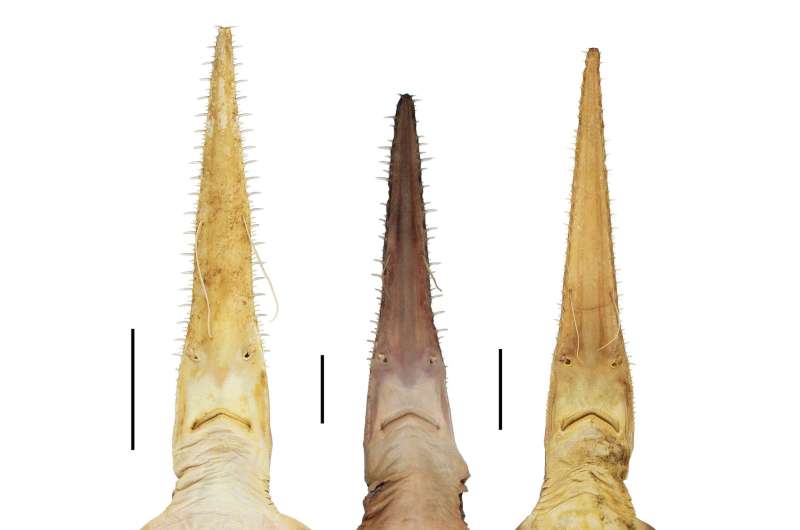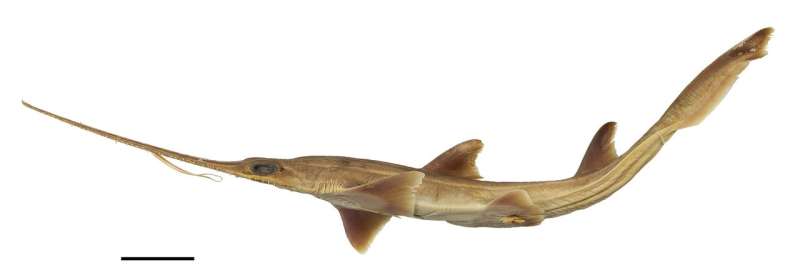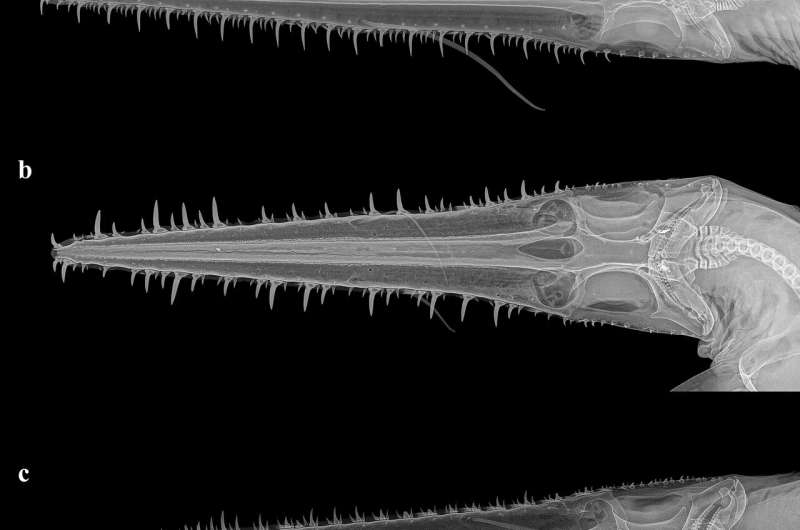Brand new shark(s), doo doo, doo doo doo doo

Not one, but TWO new species of the rarely seen six-gilled sawsharks have been found in the West Indian Ocean by an international team of marine scientists.
The newly discovered Pliotrema kajae and Pliotrema annae - affectionately known as Kaja's and Anna's six-gill sawsharks—were discovered during research investigating small-scale fisheries operating off the coasts of Madagascar and Zanzibar.
Publishing their findings today in the journal PLOS ONE, the study team say the discovery of two new sharks highlights how little we still know about life in the ocean and the impact we are having on it.
Lead author Dr. Simon Weigmann, based at the Elasmobranch Research Laboratory in Hamburg, explained:
"The six-gill sawsharks are really quite extraordinary as most sawsharks have five gill slits per side.
"So it was really exciting to find a new six-gill sawshark species and to find two new species—well that was simply astonishing!
"Knowledge of sawsharks in the western Indian Ocean is generelly still scarce. But considering their known depth distributions, both new species are likely affected by fishing operations.
"This assumption, combined with the limited range and apparent rarity of both new species, raises concerns that they are vulnerable to overfishing and might be in continuing decline.

"This could be particularly alarming for Anna's six-gill sawshark due to its very small known range, rarity and occurrence in shallow waters as the species is only known from depths of 20 to 35 m."
Two rostra of P.kajae were collected by Dr. Ruth Leeney based at the Natural History Museum in London and many further specimens of this new species were found in different museum collections. The two specimens of P.annae were collected by Ph.D. student Ellen Barrowclift, Dr. Andrew Temple and Dr. Per Berggren from Newcastle University, UK, and Dr. Narriman Jiddawi from the Institute of Fisheries Research, Zanzibar.
Dr. Temple, a co-author on the paper, said:
"Last year our team highlighted the massive underreporting of sharks and rays caught in the South West Indian Ocean and the urgent need to expand efforts globally to assess the impact of these fisheries on vulnerable species.
"The discovery re-enforces both how important the western Indian Ocean is in terms of shark and ray biodiversity, but also how much we still don't know."
Dr. Berggren, a co-author on the paper and leader of Newcastle's Marine MEGAfauna lab, adds:
"This project is also testament to the value of scientists working with local communities. Without the fishers help we would not have discovered these animals. Their knowledge of their environment is unparalleled and it is our mission to help them preserve the marine animals and ecosystems they rely on to survive."

As its name suggests, the sawshark is a type of shark best known for its saw-like snout. Found mainly in the temperate waters of all three major oceans (with the centre of distribution in the western Pacific Ocean), the number of sawsharks has declined in the past couple of decades due to commercial fishing.
Sawsharks can reach up to about 1.5 metres in length and have a long snout edged with sharp teeth which alternate in size (smaller teeth are inserted between larger teeth).
They also has a distinctive pair of barbels in the middle of the snout—whisker-like sensory organs around the shark's mouth which help the shark detect its prey.
Even though the sawshark and sawfish share similarities in appearance, they differ in several aspects. Sawfish are larger, they don't have barbels, and their gills are located on the bottom side of the body (like typical for rays).
Sawsharks are carnivores, living on a diet of fish, crustaceans and squid, and use their serrated snout to kill their prey. Fast movement of the snout from side to side cuts the prey into fine pieces that can be swallowed easily.
Both new species differ from the only previously known six-gill species, Pliotrema warreni, in the position of their barbels: in P. kajae and P. annae, these are situated approximately half way from the tip of the saw—the rostral tip—to the mouth, compared to P. warreni, where they are about two thirds of the way down, much closer to the mouth.
A special feature of P. annae is the generally shorter rostrum as compared to P. kajae and P. warreni.
More information: "Revision of the sixgill sawsharks, genus Pliotrema (Chondrichthyes, Pristiophoriformes), with descriptions of two new species and a redescription of P. warreni Regan." Simon Weigmann, Ofer Gon, Ruth Leeney, Ellen Barrowclift, Per Berggren, Narriman Jiddawi and Andrew Temple. PLOS ONE
Journal information: PLoS ONE
Provided by Newcastle University





















